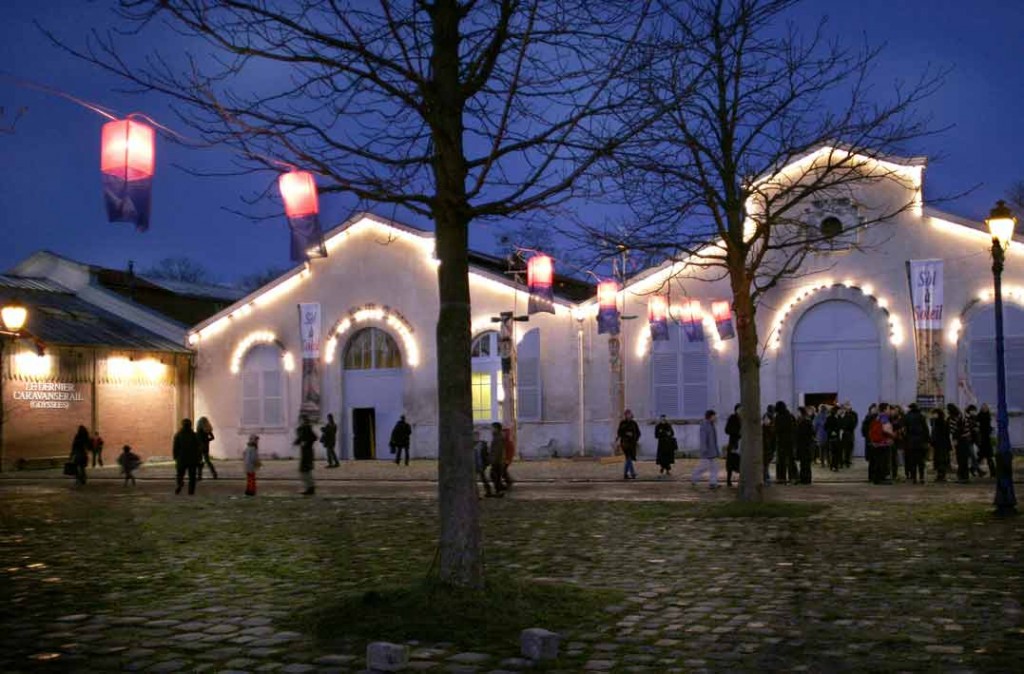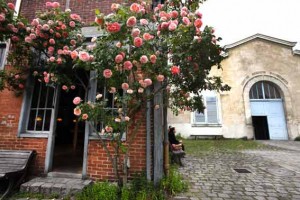The Théâtre du Soleil
Ariane Mnouchkine, born 3rd March 1939 at Boulogne-sur-Seine, is the director of theatre company, the Théâtre du Soleil, which she founded in 1964 with her contemporaries of the ATEP (The Theatre Association of the Students of Paris). In 1970, the Théâtre du Soleil created 1789 at the Piccolo Teatro in Milan, where Giorgio Strehler warmly welcomed and gave his support to the young company.

The company then went on to choose its home on the outskirts of Paris at the Cartoucherie, a former bullet-making factory, in the Bois de Vincennes. The Cartoucherie enabled the troupe to expand on the meaning of theatre as a mere architectural institution, focussing on the concept of the theatre being a place of haven rather than just complying with the traditional architectural notions of a theatre building, and this at a time when urban change and development in France was transforming the place of man in the city and the place of theatre in the city. In the Cartoucherie, the Théâtre du Soleil found the necessary tool to create and present the type of popular yet high-quality theatre dreamed of by Antoine Vitez and Jean Vilar. The troupe invented new ways of
working and privileged collectively devised work, its aim being to establish a new relationship with its audience and distinguishing itself from bourgeois theatre in order to create a high-quality theatre for the people.
From the 1970s onwards, the troupe became one of France’s major theatre companies, both because of the number of artists working in it (more than seventy people a year) and because of its glowing international reputation. Attached to the notion of the theatre troupe as tribe or family, Ariane Mnouchkine founded the ethic of the group on certain elementary bases: everyone working at all levels, everyone on the same wage, and on stage, the definitive casting only decided upon once many different actors have tried many different roles. Today, the Théâtre du Soleil is one of the last theatre companies in Europe to continue to function in such
a way.

The adventure of the Théâtre du Soleil has been continuing for more than forty years, thanks to the faithfulness and affection of a large audience both in France and abroad. Its development is marked by a ceaseless questioning of the role it has to play, of the place of theatre in society and of its capacity to represent its day. The Théâtre du Soleil’s commitment in treating the great political and human questions from a universal angle goes hand in hand with its research on the great theatrical forms and the convergence of Oriental and Western arts.
Timeline
1964 – 1970
In 1964, Ariane Mnouchkine founds the Théâtre du Soleil with her contemporaries of the ATEP (The Theatre Association of the Students of Paris) and directs its first production, Maxim Gorki’s Petit-Bourgeois (or the Philistines), from the adaptation by Arthur Adamov, at the MJC at Porte de Montreuil.
The same year, she co-writes the script of Philippe de Broca’s film That Man from Rio, a film produced by her father, Alexandre Mnouchkine.
The Théâtre du Soleil then collectively devises Captain Fracasse after Theophile Gautier in 1965, Arnold Wesker’s The Kitchen in 1967 and Shakespeare’s A Midsummer Night’s Dream in 1968. The texts are adapted by Philippe Léotard.
In 1969, the Théâtre du Soleil creates Les Clowns, in collaboration with the Théâtre de la Commune d’Aubervilliers.
The production runs in Paris and on tour (Théâtre de la Commune d’Aubervilliers, the Avignon Festival, the Piccolo Teatro, the Elysée Montmartre) – 40,000 spectators.
In 1970, the Théâtre du Soleil moves into the Cartoucherie in the Bois de VIncennes first to rehearse, and then transforming it into a theatre.
1970-1980
In 1970, the Théâtre du Soleil creates 1789, a piece about the French Revolution, at the Piccolo Teatro in Milan,then its follow-up, 1793, which is created three years later at the Cartoucherie. This production runs in Paris andthen on tour (Villeurbanne, Besançon, Caen, Le Havre, Martinique, Lausanne, Berlin, London, Belgrade) – 384,000 spectators.
In 1974, Ariane Mnouchkine shoots her first film, at the time of the last performances of 1789 at the Cartoucherie. In this way, she was able to give the spectators of this devised production an unedited record of the work going on at that time in her theatre company.
In 1975, the Théâtre du Soleil creates L’Âge d’Or – a first sketch, a collectively devised piece using Commedia dell’Arte masks to recount the contemporary world. The production runs in Paris and on tour to Warsaw, Venice, Louvain-la-Neuve, and Milan – 136,000 spectators.
In January 1977, work begins filming the feature-length Molière, directed by Ariane Mnouchkine, with the actors of the Théâtre du Soleil and, on this occasion, certain notable actors from outside the troupe, like Jean Dasté. The shoot lasts for six months, and for the first time in French cinema history, involves television companies (Antenne 2, RAI) in the production of the film.
In 1979, the Théâtre du Soleil creates Méphisto, ou le Roman d’une carrière, after Klaus Mann, adapted by Ariane Mnouchkine. The production runs in Paris and on tour – Avignon Festival, Louvain-la-Neuve, Lyon, Rome, Berlin,Munich, Lons-le-Saunier – 160,000 spectators.
1981-1998
From 1981 onwards, the Théâtre du Soleil enters into a period later described by Ariane Mnouchkine as when ‘the work of the Théâtre du Soleil was inscribed in a dialectic movement between the search for contemporary theatre and a periodic need to go back to learn from the source.’
In 1981, Ariane Mnouchkine confronts the troupe with Shakespeare’s history plays and comedies, in a quest to learn from this master, who was playwright as well as director of a troupe. This results in the creation of Richard II in 1981, of Twelfth Night in 1982, and of Henry IV Part 1 in 1984. The production runs in Paris and on tour – Avignon festival, Munich Festival, Los Angeles, Berlin – 253 000 spectators.
In 1985 begins a collaboration between Ariane Mnouchkine and Hélène Cixous, a collaboration which still exists today. Cixous will go on to write several plays for the company as well as accompanying its collectively devised work.
In 1985, the Théâtre du Soleil creates L’HIstoire terrible mais inachevée de Norodom Sihanouk, roi du Cambodge, written by Hélène Cixous, and a contemporary tragedy about Cambodia on the brink of the genocide. The play runs in Paris and on tour to Amsterdam, Brussels, Madrid, Barcelona – 108,000 spectators.
In 1987, L’Indiade ou l’Inde de leurs rêves, a historical drama by Hélène Cixous, recounting the birth of modern India and the Partition of 1947, opens in Paris and then goes on to tour to Tel Aviv – 89,000 spectators.
In 1989, commissioned by the National Assembly, and with the company, Ariane Mnouchkine directs the film La Nuit Miraculeuse, a humanist Christmas fairytale, to celebrate the bi-centenary of the French Revolution. The National Assembly and the Place de la Concorde are reserved on certain nights exclusively for the film shoot.
Between 1990 and 1992, the company performs the Les Atrides (The House of Atreus) cycle: Euripides’ Iphigenia at Aulis and Aeschylus’ Oresteia (Agamemnon in 1990, The Libation Bearers in 1991 and The Eumenides in 1992).
The production runs in Paris and on tour to Amsterdam, Essen, Sicily, Berlin, Lyon, Toulouse, Montpellier, Bradford,Montréal, New York and Vienna) – 287,000 spectators.
In 1994, La Ville Parjure, ou le réveil des Érinyes, by Hélène Cixous opens in Paris. The production runs in Paris and on tour to Liège, Recklinghausen, Vienna and the Avignon Festival – 52,000 spectators. The piece is adapted to a film directed by Catherine Vilpoux, in which alongside images of the stage version are juxtaposed with archival documents recounting the ‘bad blood’scandal, the real event at the origin of Cixous’ epic fable.
In 1995, Molière’s Tartuffe opens in Paris and then goes on to tour to Vienna, Avignon Festival, Saint-Jean d’Angély, La Rochelle, Vienne, Copenhagen and Berlin – 122,000 spectators. The creative process and the daily life of the troupe during the rehearsal period is the subject of the documentary film, Au Soleil même la nuit, directed by Eric Darmon and Catherine Vilpoux, in harmony with Ariane Mnouchkine.
In 1997, Hélène Cixous collaborates on the writing of Et soudain des nuits d’éveil, a collectively created piece about the exile and destruction of the Tibetan people. The play runs in Paris and on tour to Moscow – 55,000 spectators.
1999-2009
In 1999, Tambours sur la Digue, sous forme de pièce ancienne pour marionnettes jouée par des acteurs (The Flood Drummers), written by Hélène Cixous opens in Paris and then tours to Basle, Anvers, Lyon, Montréal, Tokyo, Seoul and Sydney – 150, 000 spectators. In 2001, Ariane Mnouchkine directs the film adaptation of the stage play at the Cartoucherie with the actors of the company.
In 2003, the Théâtre du Soleil creates Le Dernier Caravansérail (Odyssées), an epic play in two parts (Le Fleuve Cruel and Origines et Destins) which relates the stories of refugees from and throughout the world. The play runs in Paris and on tour to the Avignon Festival, Rome, Quimper, Bochum -the Ruhrtriennale Festival, Lyon, Berlin, New York (Lincoln Center Festival), Melbourne and Athens – 185, 000 spectators.
Ariane Mnouchkine also directs the film version of the play, filmed entirely at the Cartoucherie, transformed for the occasion into a real film studio.
In December 2006, the Théâtre du Soleil creates Les Ephémères, a piece in two parts. The play runs in Paris and on tour to Quimper, the Athens Festival, the Avignon Festival, the Buenos Aires Festival, the Festival Poa em Cena in Porto Alegre, Sao Paulo, Taipei, the Wiener Festwochen in Vienna, Saint-Etienne, New York (Lincoln Center Festival) – 160 000 spectators.
Les Éphémères was filmed by Bernard Zitzermann during performances at the Comédie de Saint-Etienne in June 2008 (co-produced by Théâtre du Soleil, ARTE, and Bel Air Media).
In September 2009, Ariane Mnouchkine the Norwegian government awards Ariane Mnouchkine the International Ibsen Prize in recognition of her services to theatre.
2010 -2013
In February 2010, the Théâtre du Soleil creates Les Naufragés du Fol Espoir (Aurores) at the Cartoucherie, a collectively devised creation written in part by Hélène Cixous, and directed by Ariane Mnouchkine. The play runs inParis and on tour to Lyon (Les Célestins), Nantes (Le Grand T), the Hellenic Festival in Athens, Sao Paulo, Rio de Janeiro, the Festival Poa em Cena in Porto Alegre, the Festival Santiago a mil in Santiago de Chile, the Wiener Festwochen in Vienna, the Edinburgh International Festival, Taipei – 180 000 spectators.
2014
In May 2014, the Théâtre du Soleil creates at the Cartoucherie Macbeth. A Tragedy by William Shakespeare. Translated and directed by Ariane Mnouchkine. Music by Jean-Jacques Lemêtre.
(May, 29) 50th anniversary of the Théâtre du Soleil
